Jamie Sheffield's Blog, page 17
May 7, 2013
3 Simple Ways to Make Editing Easier!

Efficient and effective editing is critical to the success of your writing; without it, you will turn readers off with typoes and odd word usements before they get the chance to fall in love with your story, characters, and imagery.
It would be great if our work as writers was done when we finished the rough draft, but it's really just begun. Solid editing delivers your writing from an idea all the way to a finished product that will grab your audience by their hearts and minds.
There are three ways to make editing easier for you, which will in turn make reading your work easier for your audience ...
1) Accept that editing requires numerous read-throughs and revisions
Editing can't be a "one and done" task. At the very least, you should have a person beside yourself: read your rough draft for content (story, storyline, pacing, conflict/resolution, and characters); after fixing the rough draft content, have another person do the copy-editing (grammar, spelling, format, clarity, etc.); when the writing is polished and read for publication, have it proofread by another person (someone to go over the whole thing with a fine-toothed comb for any lingering issues). Any or all of those stages may need to be repeated multiple times (possibly with multiple readers) before you are ready to go to print.
Anyone who insists that they can edit their own work is lazy, lying, or deluded.
You need to have outside eyes and minds looking at your writing to edit effectively and efficiently ...this is not a part of the self-publishing process that you can do by yourself.
2) Use the right tools for each stage of the writing/editing job
A surgeon uses knives and clamps and sutures. A carpenter uses a hammer and nails and a saw. A chef uses the best ingredients, tried and true recipes, and pots/pans. Writing (and editing) is the same, in that you need to use the best tools in the proper manner to get optimal results.
I do my research and planning on paper notepads with pens. I write using my laptop and Microsoft Word. My content-readers read the story in pdf format, and then meet with me to tell me what they thought. I share the next version of the story in doc format, so that my copy-editor can tear the story apart (and then later, I can put it back together) with track-changes. I like to read the print-ready final copy on paper.
That's my process. I know lots of authors who HATE track-changes, and prefer their editors use a red pen or manipulate multiple versions of the story with GoogleDocs. I like a face to face meeting to discuss the big-picture of the story, but hate going through copy-editing with my editor. How it works for me is unimportant (except to me) ... you need to explore the options out there, and pick the method that works for you (by which I mean yields the best finished product for you and your readers).
The only hard and fast rule should be to vary how you interact with your text and editors at each stage of the process, so that it is seen and modified in different ways.
3) Do your final proof with paper and pen and stickies
As both a reader and a writer, I feel strongly that printed paper is magical. I like the way that it feels and smells and looks ... I love reading on my Kindle and iPad and Kobo, but still feel that I get the closest read with a printed-paper book (perhaps in the same way that I get a closer shave with a real razor than with an electric one).
When a story of mine has been through content reading/editing and copy-editing and proof-reading with outside readers, I like to get a printed copy of it, and go through with an actual red pen to look for problems. I almost always find something (or a number of somethings) to fix or un-fix. More than that, it also gives me a chance to pretend that I'm reading it with new eyes, and to explore the things about it that I found interesting enough to write down in the first place.
I haven't come across a perfectly edited/proofed story in the last ten years, including all of the hundreds of books that I've read in that time ... there's always something that can be fixed
I hope that these three tips will help improve your editing process.
Thanks,
Jamie
Published on May 07, 2013 09:15
April 30, 2013
An Update on my Current Writing Projects
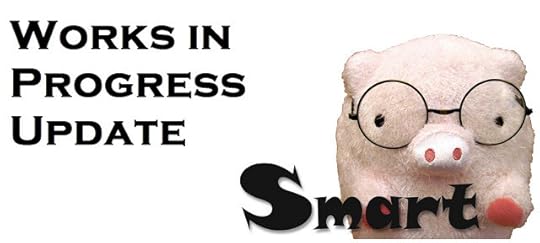
Current eBook Project
I'm in the middle of writing a Tyler Cunningham eBook set in the summer of 2002, which takes a look at his first case (and the evolution of Tyler into a consulting detective).
I haven't come up with a title for the work yet, which also explores his intentional homelessness a bit. I anticipate this eBook coming in at between 15K and 20K words (a bit longer than "Mickey Slips") in its final form.
Podiobook Project
I've written the rough draft of the story that the SmartPig Creative Team decided would be well suited to our proposed audiobook/podiobook project, and need to find the time to go back through and break the story, tentatively titled "240 Minutes" into the desired four segments.
Second Novel Project, Summer 2013
I'm adding everyday to my collection of notes and ideas and web-links to information for the upcoming second novel project this summer.
The novel will be set in the Adirondacks (of course), and delves more deeply than "Here Be Monsters" did into the history of the Park, especially the Great Camps (and the relationships between the Great Camp owners and staff and other 'year-rounders').
Another writing challenge that I'm excited about is that I will be writing chapters in alternating perspectives (two parts of the same story told by different people on a course designed to intersect near the end of the novel). The majority of the story will be told from Tyler's perspective, but it will be interspersed with this other voice.
Sales Update
Sales of "Here Be Monsters" and "Mickey Slips" continue to move along nicely, with fits and starts (and the occasional stop), and by the end of April, my math put the combined totals for my books at roughly 1,100 copies in the hands of readers.
Excellent reviews continue to come in for both books at Amazon and GoodReads, and this blog now routinely enjoys over 100 visitors per day, with some days near 400 visitors.
I am hoping that the addition of another eBook, the podiobook, and eventually the second full-length novel, will continue to grow the SmartPig/Sheffield/Cunningham brand over time.
Thanks for all of your help and interest and for reading!
Jamie
Published on April 30, 2013 09:04
April 29, 2013
5 Deadly Traps, and How Self-Publishers Can Avoid Them!
 Self-publishing your own book is easier than it has ever been before, but that doesn't mean that the process is easy ... or risk-free.
Self-publishing your own book is easier than it has ever been before, but that doesn't mean that the process is easy ... or risk-free.Traditional publishers and publishing houses did/do lots of things for authors ... all of those things still need to get done, and thinking or acting otherwise can lead to non-existent (or slow) sales, poverty, boredom, reduced numbers of groupies, angst, depression, lack of exposure, and shuffling around your house in sweatpants and bunny-slippers for days/weeks at a stretch.
{Note: traditional publishing can lead to all of these things also, but read on for ideas on how to avoid them}
Please think of this article as a very basic introduction to the facts of life that an indie-author has to learn if they want to avoid becoming angry and crazy and bitter ... there is a wealth of information about each of the traps discussed below, but awareness is the key to avoiding them, and this article should at the least help with that issue.
Trap #1 - Readers, Editors, Proofers Your book ends up being both personal and familiar to you by the time you are done writing it ... don't try to content-read, edit, and proof your own writing ... it just doesn't work.
You have to bring in outside eyes to read it through (at least) three different kinds of reading. Content reading is a first look at your writing, to see how the story flows, and get a feel for the characters, the arc, and conflict/resolution. Editing involves reading the essentially finished story for grammar and spelling and such. Proof-reading is a final look at the finished product, prior to sending it off to be published.
Each reading of your book is different, and each is vital. You cannot do these read-throughs of your book on your own, and expect a quality final product.
Trap #2 - Cover Design & Layout The cover is the first (and sometimes only) thing that people will use to make a judgment about your book ...despite the old saying, people judge books by their covers all the time.
This is also true of the layout and look of your book inside the covers; if the book layout and design is unappealing, people may put yours back and grab another.
It's worth researching covers and inside layouts to find out what is standard and/or eye-grabbing in your genre. It may be that you're able to produce a nice looking cover and to format the interior, but if you're not sure, seek help. It's not worth compromising the look (and sales) of your book by producing a crappy looking cover and inside to save a few bucks.
A sub-set of trap #2 is the front-matter and back-matter of your book. Do some research online. Go to a bookstore and see how books that you like manage these things. Ask other indie-authors what they include, and how they prefer to do it. This is an easy to avoid trap, but you have to put in the time.
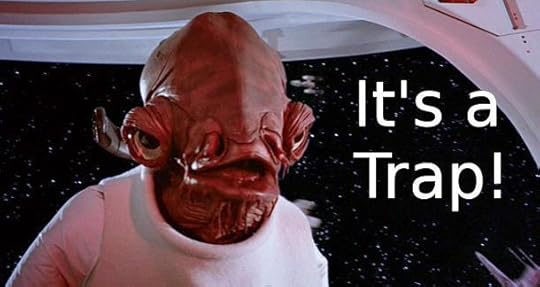
Trap #3 - Printing and Binding and Distribution This is one of the biggies, for a variety of reasons. In days of yore, many self-publishers paid thousands of dollars to have a few hundred copies of their books printed, only to spend the next 40 years with boxes of poorly printed books sitting in their garage (having sold 30 copies to some friends and family ... and then nobody else), with no way for bookstores beyond shouting distance to know about the existence of your book
The problems with that model were/are: Print On Demand (POD) technology has come so far that it's both quick and economically feasible to print one copy of my book. This means that I don't have to warehouse hundreds or thousands of copies of my book, waiting/hoping for sales to catch up with my out-of pocket printing costs.Being able to see exactly what your finished product will look like means never having to open a box of books from your underemployed (for a reason) printer and gawking (and/or crying) at a weird font or odd layout or crappy cover colors.Some of the POD publishers (I'm thinking most especially of Amazon's CreateSpace) can connect my book with booksellers anywhere on the planet ... this was not the case with a cottage industry printer who shipped my finished product straight to me, and was done.There are lots of different companies out there involved in printing/binding/distribution, and your job is to do some googling, some reading, some outreach to other indie-authors, and find the one that has the right mix for you.
Trap #4 - Marketing and Promotion
This is the biggest trap of all for most authors, especially those of us who self-publish. The best book in the world will never sell (except by accident) without a detailed and ongoing marketing and promotion plan.
"If you build it, they will come." - not true.
This may have worked for Kevin Costner in "Field of Dreams", but in a market literally flooded with self-published books, it doesn't stand up to a reality check.
Your first job as an author is to write the best book that you can (avoiding trap #1 is a big help). After that is done, you need to produce a book that looks and feels great, to you and your readers, and could theoretically get into the hands of every person who might be interested in reading it (an awareness of trap #2 and #3 helps make this work). The final piece in making sure that your book finds an audience is to help your audience find your book.
This will involve a mixture of local and regional and worldwide outreach and activity.
At the local level, you should bring copies of your book to all booksellers that connect with your target audience within an hour or two. Make sure that they know that you're willing to come in for signings or talks.
At the regional level, you should send a press release to every newspaper, radio station, and magazine that caters to your book's intended audience. Read and research the best ways to produce this press release for your market.
Your global information and outreach efforts will center on your author blog or website; explore the blogs and websites of authors that you admire, and try to provide the same information and level of service (in much the same vein, you should also take advantage of the Amazon Author's Page program, if possible). In addition, you should connect with readers (and other writers) online, though such social networks as Facebook, Twitter, GooglePlus, GoodReads, and YouTube. Another possible means of exposure for your writing worth considering can be the blogs or websites of other writers.
Thoughtful pricing of your books, and taking careful advantage of opportunities to give ebook copies away on targeted days or in contests are good ways to get your books into the hands of people who can read and enjoy and positively review them.
When in doubt, read and research more about marketing and promotion ... remember, it's not what writers do, so there's nothing wrong with not knowing anything in the beginning. The corollary to that is that you need to keep your research and efforts in marketing and promotion under control because doing too much can be it's own kind of trap, and drive you nuts.

Trap #5 - Tiger Traps The fifth, and final, trap I'll be discussing in this article is far and away the most dangerous ... actual tiger traps!
Where the other traps can leave a you frustrated and impoverished, tiger traps can leave self-published authors unlucky enough to fall into them bleeding at the bottom of a filthy hole in the ground (with the real possibility that an actual tiger may fall on top of you at some point, and either crush you or attack in a frenzy of pain and fear).
Fortunately, as with the other traps discussed above, tiger traps can be avoided by following a few simple rules:
Avoid traveling the backcountry in places likely to be filled with tigers (or tiger hunters).Failing that, continuously hurl heavy objects (think watermelons or cinder-blocks) in front of you to expose tiger traps before you fall into them.If that proves difficult, study the picture above, and look for rectangular patches of ground-cover with growth patterns different from the surrounding ground, indicative of tiger traps ... avoid these.As a backup to the above measures, consider wearing gigantic snowshoe-like baskets on your feet to prevent your falling into traps you cannot otherwise avoid.
These measures should help you avoid the most common pitfalls of self-publishing, as well as dying in a tiger-trap.
Good Luck!
Thanks,
Jamie
Published on April 29, 2013 09:55
April 27, 2013
17 Ways that Creative Writing is Way Better than Marketing!
 I'm writing again.
I'm writing again.I stopped writing for a couple of weeks for perfectly good and valid reasons, but I missed it and now I'm writing again.
I published an eBook three weeks ago, and haven't written much since them ... except for blogging and marketing and such. Blogging and marketing and such are part of the gig when you self-publish, but they're not why we self-publish ... the writing is....
I started on the next book in my ongoing series yesterday, and had a ball getting through some planning and research and a bit more than 1,000 words. I'm hoping to get in a couple of hours of writing this afternoon, and every day until I finish a first draft.

The happy glow that I brought to the dinner table last night was due to my writing, and it made me reflect on why I love writing (and dislike marketing) so much ... I'm going to share some of the reasons with you now.
creative writing is telling storiesmarketing is selling storiescreative writing lets my brain out to play, running past the "Don't walk on the Grass" signsmarketing forces my brain to wait in lines and march in stepcreative writing allows me to explore different worlds and people and endless possibilitiesmarketing asks me to focus on the numbers and the reach of my words/effortscreative writing makes the people who read my stuff ... happymarketing makes the people who read my stuff ... buy my stuff creative writing makes me smarter and happier and hopefuller and creativer (see, I made up those last two awesome words!)I skipped numbers ten through seventeen because I was getting bored, and am certain that if you've read this far down, that you can supply your own author/reader-specific answers.
I love the creative writing process, but can appreciate the need for the marketing side of my self-publishing efforts. Without crap on my boots, I might not appreciate watching (and interpreting) the clouds and stars so much.
Having spent a couple of weeks away from the process of daily writing sharpened my focus, whet my appetite, and allowed my back-brain to toss around and sort and polish ideas while I busied myself with other things (like the rock tumbler that chugged along for weeks in my closet when I was a kid).
It's possible that if I didn't spend my time on other, not-creative-writing stuff, that I would be less ready now to start, work on, and finish my current project.
Morning meditations, with coffee and dogs ....
Thanks,
Jamie
Published on April 27, 2013 04:56
April 25, 2013
Puck
Today's blog entry has almost nothing to do with my writing (that being said, Puck does help me write and edit my work...although he is overly fond of simple sentences)...I simply felt like writing a short piece to go along with some pictures of our new rescue-dog, Puck.
[image error] Puck on the day that we brought him home...not entirely trusting us
Puck came to live with us shortly after our beagle Cedar died.
He had been waiting at the Tri-Lakes Humane Society fror a new home for a while because he has a checkered past. He was arrested, along with the dog he was living with, for menacing and biting someone. He has lots of scarring on his body, some of which look like they're from shotgun pellets; he's terrified beyond reason (literally) by loud noises (gunshots, champagne corks, doors slamming, thunder).
 Puck (far left) posing with us for our Xmas picture...still not fully sureWhen we took him to the vet for his first visit, we were in for a number of surprises. They knew him from his previous life, when he had come to them in grave condition from having his back end run over and crushed in a dog v. vehicle interaction. He started shaking and crying before we got in the door, and growled and snapped at the vet-techs who wanted to take his temp and clip his nails and give him a shot...he had to be knocked out before they could touch him.
Puck (far left) posing with us for our Xmas picture...still not fully sureWhen we took him to the vet for his first visit, we were in for a number of surprises. They knew him from his previous life, when he had come to them in grave condition from having his back end run over and crushed in a dog v. vehicle interaction. He started shaking and crying before we got in the door, and growled and snapped at the vet-techs who wanted to take his temp and clip his nails and give him a shot...he had to be knocked out before they could touch him.He's a sweet boy, but a bit broken. He loves us, is cuddly and affectionate with everyone in our family, but there's always fear at the edge of his consciousness...fear of being hurt, hit, harassed and hurled back into a tiny cage if we decide he's not worth it (we won't, but how can he know that?).
 Easter harassment that he put up with...because he loves usHe gets scared and/or lonely and/or bored in the middle of the night, most nights, and will come into our bedroom to wake me up with a pat or a kiss or a whine. He doesn't need food or water or a chance to pee (although he will always take the opportunity to eat and run outside for a minute)...he just wants to talk.
Easter harassment that he put up with...because he loves usHe gets scared and/or lonely and/or bored in the middle of the night, most nights, and will come into our bedroom to wake me up with a pat or a kiss or a whine. He doesn't need food or water or a chance to pee (although he will always take the opportunity to eat and run outside for a minute)...he just wants to talk.So I've gotten into the habit of getting up in the dark to cuddle with him on the couch for a bit (those who know me know that I'm a mostly useless zombie between the hours of 10pm and 3am) and then either go back to bed or spend the rest of the night on the couch with Puck. I'm not sleeping as well as I'd like, but he needs me.
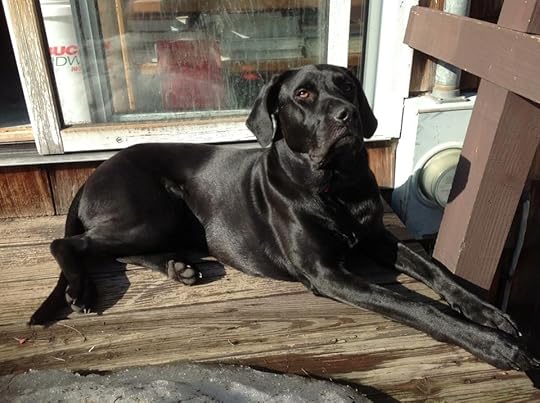 Puck working on his tan on our deckPuck's settled into our home about as well as he's going to, and we're used to him and his foibles. He's not perfect by any means, but none of us in this house in the woods are in any position to throw stones; we're hiding (and hidden) from the rest of the world on purpose.
Puck working on his tan on our deckPuck's settled into our home about as well as he's going to, and we're used to him and his foibles. He's not perfect by any means, but none of us in this house in the woods are in any position to throw stones; we're hiding (and hidden) from the rest of the world on purpose.The UPS-guy has a relationship with Miles (our other lab rescue, who loves Puck) involving some barking and some cookies and sometimes Miles climbs into the back of the truck to help Craig in finding the right box...Puck doesn't understand the rules of this social contract...he barks and cowers and suspects poisoned cookies and thinks that UPS is going to steal Miles.
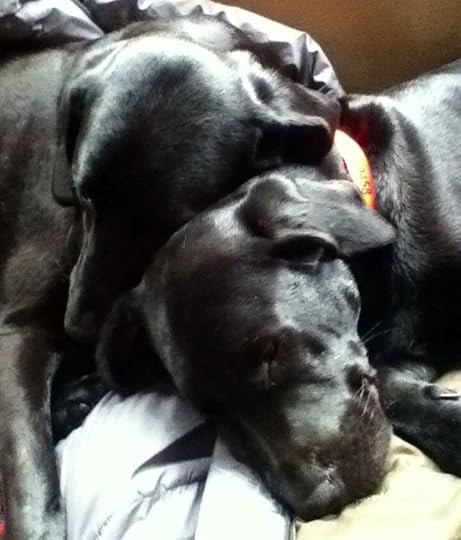 Miles (left) and Puck (right) napping on the couchHe's ours, we're his, none of us perfect (or even close). We know the sore spots on his back and butt from earlier injuries, and avoid them. He loves us (which at the end of the day is his only defined duty) and trusts us the best he can...his particular needs and damage are a part of what endear him to us.
Miles (left) and Puck (right) napping on the couchHe's ours, we're his, none of us perfect (or even close). We know the sore spots on his back and butt from earlier injuries, and avoid them. He loves us (which at the end of the day is his only defined duty) and trusts us the best he can...his particular needs and damage are a part of what endear him to us.Puck will never be easy, but he will always be ours!
Thanks,
Jamie
Published on April 25, 2013 06:16
April 24, 2013
Get My Next eBook Free & Before Everyone Else!
I first published "Here Be Monsters" a bit less than 5 months ago. "Mickey Slips" came out about 3 weeks ago.
In that time, my books have been bought in print form or downloaded more than 1000 times! I find this both incredible and amazing and humbling.
A less impressive statistic has to do with the number of reviews my books have gotten. While the reviews have been great, there just haven't been enough of them (about 45 between Amazon and GoodReads for both books combined, which works out to roughly 4%).
I would love to get more reviews on these website from the people who have read my books, and I have a couple of ways that I hope to accomplish this feat. I recently wrote a blog entry offering to give signed copies of "Here Be Monsters" to a few randomly selected people who rate/review either of my books, but I want to do more for the people who are willing to help me out by posting a review and rating on Amazon and/or GoodReads.
I want to give each of them an advance copy of my next eBook...each person who writes a review for either book, and sends me an email (jsheffield@gmail.com) will get a FREE copy of my next ebooka week before it is available for sale.
I need your email so that I can send the eBook to you in mobi/epub/pdf format; I won't use your email address for anything else, and won't give or sell it to anyone else.
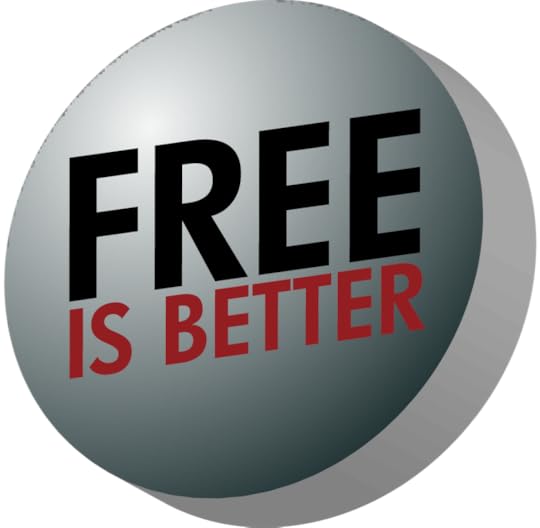 So...there it is...write a review for either of my books, and I'll give you a copy of the next ebook a week before anyone else on Earth gets a chance to see it.
So...there it is...write a review for either of my books, and I'll give you a copy of the next ebook a week before anyone else on Earth gets a chance to see it.
Thanks,
Jamie
In that time, my books have been bought in print form or downloaded more than 1000 times! I find this both incredible and amazing and humbling.
A less impressive statistic has to do with the number of reviews my books have gotten. While the reviews have been great, there just haven't been enough of them (about 45 between Amazon and GoodReads for both books combined, which works out to roughly 4%).
I would love to get more reviews on these website from the people who have read my books, and I have a couple of ways that I hope to accomplish this feat. I recently wrote a blog entry offering to give signed copies of "Here Be Monsters" to a few randomly selected people who rate/review either of my books, but I want to do more for the people who are willing to help me out by posting a review and rating on Amazon and/or GoodReads.
I want to give each of them an advance copy of my next eBook...each person who writes a review for either book, and sends me an email (jsheffield@gmail.com) will get a FREE copy of my next ebooka week before it is available for sale.
I need your email so that I can send the eBook to you in mobi/epub/pdf format; I won't use your email address for anything else, and won't give or sell it to anyone else.
 So...there it is...write a review for either of my books, and I'll give you a copy of the next ebook a week before anyone else on Earth gets a chance to see it.
So...there it is...write a review for either of my books, and I'll give you a copy of the next ebook a week before anyone else on Earth gets a chance to see it.Thanks,
Jamie
Published on April 24, 2013 05:22
Get My Next eBook Free And Before Everyone Else!
I first published "Here Be Monsters" a bit less than 5 months ago. "Mickey Slips" came out about 3 weeks ago.
In that time, my books have been bought in print form or downloaded more than 1000 times! I find this both incredible and amazing and humbling.
A less impressive statistic has to do with the number of reviews my books have gotten. While the reviews have been great, there just haven't been enough of them (about 45 between Amazon and GoodReads for both books combined, which works out to roughly 4%).
I would love to get more reviews on these website from the people who have read my books, and I have a couple of ways that I hope to accomplish this feat. I recently wrote a blog entry offering to give signed copies of "Here Be Monsters" to a few randomly selected people who rate/review either of my books, but I want to do more for the people who are willing to help me out by posting a review and rating on Amazon and/or GoodReads.
I want to give each of them an advance copy of my next eBook...each person who writes a review for either book, and sends me an email (jsheffield@gmail.com) will get a FREE copy of my next ebooka week before it is available for sale.
I need your email so that I can send the eBook to you in mobi/epub/pdf format; I won't use your email address for anything else, and won't give or sell it to anyone else.
 So...there it is...write a review for either of my books, and I'll give you a copy of the next ebook a week before anyone else on Earth gets a chance to see it.
So...there it is...write a review for either of my books, and I'll give you a copy of the next ebook a week before anyone else on Earth gets a chance to see it.
Thanks,
Jamie
In that time, my books have been bought in print form or downloaded more than 1000 times! I find this both incredible and amazing and humbling.
A less impressive statistic has to do with the number of reviews my books have gotten. While the reviews have been great, there just haven't been enough of them (about 45 between Amazon and GoodReads for both books combined, which works out to roughly 4%).
I would love to get more reviews on these website from the people who have read my books, and I have a couple of ways that I hope to accomplish this feat. I recently wrote a blog entry offering to give signed copies of "Here Be Monsters" to a few randomly selected people who rate/review either of my books, but I want to do more for the people who are willing to help me out by posting a review and rating on Amazon and/or GoodReads.
I want to give each of them an advance copy of my next eBook...each person who writes a review for either book, and sends me an email (jsheffield@gmail.com) will get a FREE copy of my next ebooka week before it is available for sale.
I need your email so that I can send the eBook to you in mobi/epub/pdf format; I won't use your email address for anything else, and won't give or sell it to anyone else.
 So...there it is...write a review for either of my books, and I'll give you a copy of the next ebook a week before anyone else on Earth gets a chance to see it.
So...there it is...write a review for either of my books, and I'll give you a copy of the next ebook a week before anyone else on Earth gets a chance to see it.Thanks,
Jamie
Published on April 24, 2013 05:22
April 22, 2013
4 Ways to Win a Signed Copy of My Novel
I want to run a contest and giveaway a few copies of "Here Be Monsters"...sound good?
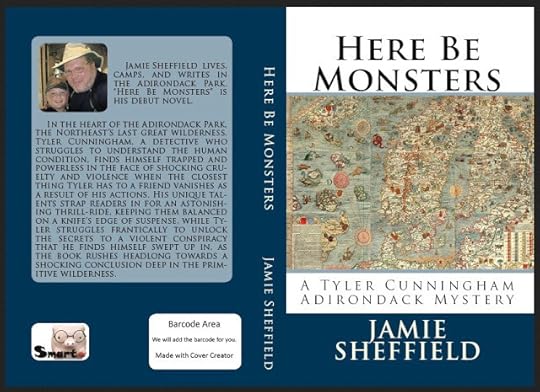 If you would like a copy for yourself (or as a present), then you can pick one of the following simple ways to get one (if you do more than one, your odds of winning a book increase):
If you would like a copy for yourself (or as a present), then you can pick one of the following simple ways to get one (if you do more than one, your odds of winning a book increase):
Write and post a review for either "Here Be Monsters" or "Mickey Slips" on Amazon and/or GoodReadsPost a link to your review (new or pre-existing, on Amazon or GoodReads) on Facebook or G+ or Twitter or your blogShare a favorite quote or scene from either "Here Be Monsters" or "Mickey Slips"(along with a link to the book mentioned) on Facebook or G+ or Twitter or your blogShare this blog entry with friends on Facebook or G+ or Twitter or your blog to spread the word about the giveaway
I'll see the reviews on Amazon or GoodReads, so you'll get credit for those ones easily. If you post about your review or a quote/scene or this blog entry, tag me, and I'll see it that way.
For each of the four from the above list that you do between now and May 5 (Cinco de Mayo!), I'll put your name in a hat. If lots of people participate in this giveaway program, I'll give away as many as five books.
I'll get in touch with the winner(s) and ask what they would like their book inscribed with, and where I should send it.
Thanks,
Jamie
 If you would like a copy for yourself (or as a present), then you can pick one of the following simple ways to get one (if you do more than one, your odds of winning a book increase):
If you would like a copy for yourself (or as a present), then you can pick one of the following simple ways to get one (if you do more than one, your odds of winning a book increase):Write and post a review for either "Here Be Monsters" or "Mickey Slips" on Amazon and/or GoodReadsPost a link to your review (new or pre-existing, on Amazon or GoodReads) on Facebook or G+ or Twitter or your blogShare a favorite quote or scene from either "Here Be Monsters" or "Mickey Slips"(along with a link to the book mentioned) on Facebook or G+ or Twitter or your blogShare this blog entry with friends on Facebook or G+ or Twitter or your blog to spread the word about the giveaway
I'll see the reviews on Amazon or GoodReads, so you'll get credit for those ones easily. If you post about your review or a quote/scene or this blog entry, tag me, and I'll see it that way.
For each of the four from the above list that you do between now and May 5 (Cinco de Mayo!), I'll put your name in a hat. If lots of people participate in this giveaway program, I'll give away as many as five books.
I'll get in touch with the winner(s) and ask what they would like their book inscribed with, and where I should send it.
Thanks,
Jamie
Published on April 22, 2013 07:45
April 19, 2013
The 3 Golden Rules to Perfectly Pricing Your Ebook!
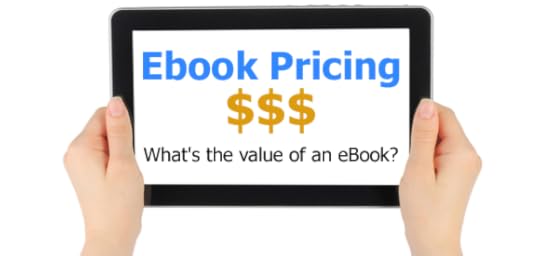
When the first eReader came out of its box, I bet there were two guys in the back of the room arguing about eBook pricing ... one yelling that they should be free, and the other shouting back that they should cost the same as print copies.
It's a sticky situation that is near and dear to my heart (as this year I've published a novel in both print and eBook formats, and a novelette solely as an eBook), so I have been doing some research. There are dozens of articles available online, and more in print magazines and books, all of them with contradictory advice and guidelines and rules.
My research and subsequent meditations brought me to:
The Three Golden Rules of eBook Pricing Free eBooks make sense because they are downloaded by more peopleCheap eBooks make sense because they cost less (per unit) to produceeBooks priced like their printed counterparts make sense because the value of a book is not in the paper
Yes, these three rules are contradictory ... deal with it!
The rules apply to every author and eBook differently at different times, depending on lots of different factors.
There is no one pricing structure for every eBook, but a thoughtful application of the Three Golden Rules (TGRs) will guide you in coming up with the right price for your eBook at every stage in your (or your eBook's) career.
All of this presupposes a pair important details that many writers skip over in their rush to fame and glory and wealth ... in order to fully explore and exploit the TGRs, writers need two things first:
a number of eBooks to offer their readerseBooks of a quality sufficient to bring readers back for more Quality and quantity of writing makes all things possible ... with it and the TGRs, a huge readership and wealth beyond the dreams of avarice is possible ...without it, even with the best possible application of the TGRs an author will likely languish in obscurity and poverty forever.
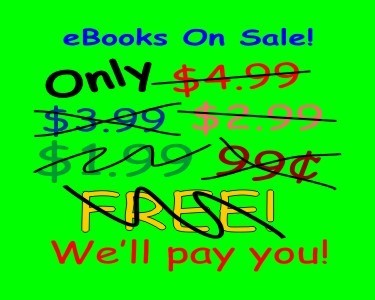
Golden Rule #1: Free eBooks make sense because they are downloaded by more people
There are gazillions of eBooks available on the internet, without a readership and proven track-record, getting people to take a chance on paying for yours is difficult. Building and/or expanding your readership is important to all but a few dozen of the most successful writers on the planet (and if you're reading this, you're not one of them ... they have minions to read for them). Giving away your eBook is a great way to increase the number of eyes that read your writing, and also to bump you up the free-ebooks bestsellers lists.
I gave away my newest eBook for 2-days, before bringing it back to its regular price, and was happy with the number of downloads that I was able to get in that time. I would certainly consider doing it again with my next eBook.
If you are giving your eBook away, you should be driving satisfied readers towards something when they finish reading your work ... another book (this one not for free), your website or blog, your fanpage on Facebook or GoodReads, ... something.
I think that even as your readership grows, it's still worth your while to give some eBooks away for free to keep finding new readers.

Golden Rule #2: Cheap eBooks make sense because eBooks cost less (per unit) to produce Printing a book costs money, every time, for every copy. The same is not true of eBooks.
Paper, ink, printing, storage, shipping are all ongoing costs of printed books that are essentially zero for eBooks (it costs something to store and ship eBook files, but so little as to effectively make my point for me). A logical argument can be made that since the per unit costs of production are so much lower for eBooks, there should be a similar reduction in price for them as opposed to printed books.
This argument carries some weight with me (and many other writers who publish their work in both print and eBook formats). A reduction in price seems logical on the face of things. A lower priced eBook can encourage more people to buy your writing, and still make you the same amount of money as your printed books. My novel is less expensive in eBook format than the print version; working out the price-point that seems most equitable to my readers and me is still a difficult question though (for me).
I do, however, question selling my novel in eBook form for substantially less than the print version for a couple of reasons ... it feels less than (or on sale, or remaindered), and unfair to print owners (who have to support the printers and Amazon and me). The truth is however, that print version owners can sell their copies to someone else, and access it regardless of the state of their technology or wifi-access or the powergrid, so it probably works out to be fair (or better) for them.
There are lots of eBooks available for 99 cents, a price which on Amazon will make the author about 30 cents per copy. This feels like a half-step up from giving the book away for free, but without the convenience of it being free. I find myself suspicious of a 99 cent eBook (I understand giving eBooks away for free, but 99 cents seems more cheap than inexpensive, if I can be allowed the distinction), and as such I choose not to place my eBooks at this price-point.
Some short eBooks of mine may end up for sale at $1.99, an in-between price that doesn't make the KDP minimum ($2.99) for the 70% royalty, but is enough above 99 cents to shake free of the stigma of the bargain-basement book.
I'm a big fan of pricing eBooks in the $2.99 to $7.99 range, and the industry number crunchers tend to bear me out. This price range is cheap enough to maximize sales without seeming too-low for quality eBooks. I very much like the idea of buying a book for the price of a coffee at Starbucks or a cheap lunch at Subway.
I've currently got an eBook for sale at $2.99, which is a price I'm comfortable with for a shorter eBook, although I (along with other eBook sages) think that $4.99 to $7.99 is more appropriate for full-length novels (which is where my novel is priced).
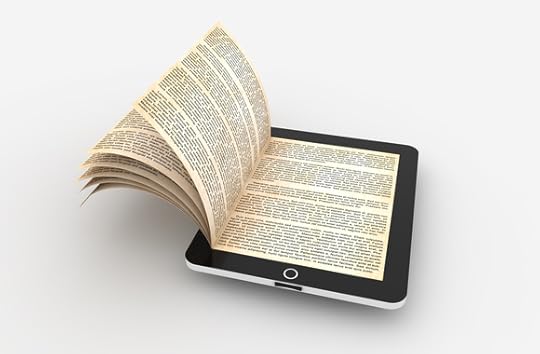
Golden Rule #3: eBooks priced like their printed counterparts make sense because the value of a book is not in the paper
Books are magic, and the magic comes from words not paper and ink and backlit e-ink. A fantastic book is just as fantastic whether your picked it up at a local bookstore or downloaded it, so why should one cost less than the other? I don't buy this argument the majority of the time, but an exception could be in the case of a Stephen King or Lawrence Block, who are masters of their markets; they can set their prices wherever they want, and people will pay it.
Another reason for charging the same (or even more?) for an eBook as compared to a comparable print version would be convenience:I can carry hundreds of eBooks with me in my backpack, no longer needing a wheelbarrow of SmartCar to accomplish this task, as I did in the days when print books ruled the Earth.I can get an eBook sequel to a book I love within seconds (not days) of finishing the first book (I've done this while away on vacation, and it felt like magic).I can search the text of the eBook for specific words and passages, and check the definitions of words while reading.I can loan my eBooks (some of them anyway) to a friend, and never suffer the anguish of having the eBooks not returned, or returned covered in grape jelly. There is a pervasive belief (feeling?) in the book-world that eBooks are somehow inferior to print books; I don't believe this to be true ... they are simply different.
That being said, for the time being, all of my eBooks will be priced lower than print versions of the same books.
Summary I hope that this exploration of the TGRs of eBook pricing is useful in highlighting current thought and the reasoning behind the pricing of eBooks as of April 2013.
The rules are all useful, but contradict each other ... and that's OK.
It's perfectly acceptable to pick your price-point anywhere along the continuum discussed above, so long as you're aware of the background and have a reason for making your pricing decision.
I will likely stick with free giveaways through the KDP Select program with my new eBooks, to give them (and my readership numbers) a bump, accompanied by longterm pricing in the range supported by market data (until such time as I'm bigger than The Beatles, can pick whimsical prices, and take daily money-baths).
I'd love to hear back from readers and writers with your experiences in the world of eBook pricing.
Thanks,
Jamie
3 Good Articles for Background & Reference & Further Reading 7 Must-Consider Strategies for Ebook Pricing, by Beth BaconHow Much Should Ebooks Cost?, by David BiddleThe Ebook Pricing Sweet Spot, by Jeremy Greenfield
Published on April 19, 2013 16:08
April 18, 2013
What's next? Reading and writing...lots of both!
Spring comes slowly to the Adirondacks, but eventually it comes.
 We still have frosts every night, but sometimes we can see the sun.
We still have frosts every night, but sometimes we can see the sun.
I'm still burning wood to heat my home, but daylight lasts until after seven in the evening, and I don't have to drive to and from work in the dark.
I've been reading a lot lately...homework. Parker books, Stephen King, Elmore Leonard, Lawrence Block. I've also been trying out some location-specific fiction writers, trying to get a feel for how good writers make a sense of place pervade their story (in the hope that I can do the same in my work). In addition, as a result of lurking in the Amazon bestsellers lists watching an eBook of mine climb the charts during a KDP giveaway, I've downloaded and have been reading a lot of what might be called 'the competition'...lots of good crime and mystery writing out there in the self-pub world.
I just published a not-so-short story, "Mickey Slips" which throws Tyler Cunningham into a messy situation that he is uniquely qualified to handle. I'm happy with the way that the story turned out, and am looking forward to the next writing projects (both literally and figuratively).
My editor took a first look at the next story, tentatively titled "240 Minutes", and we both have some shared reservations...it's a story designed around a time limit, and the pacing is a problem at the moment. Yesterday afternoon, I had some ideas about how to move things around and streamline the narrative a bit, and I'm hoping to start that process this afternoon.
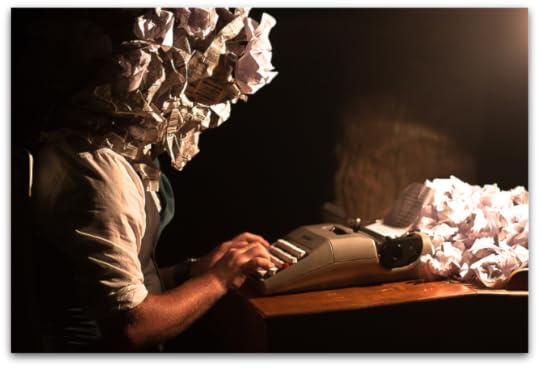 I've also been playing with the idea of a story that takes a look at Tyler's first 'case' . I had the characters and setting and feel of the story worked out a month ago, but when I started writing, the conflict rang false to me, so I put it away, hoping it would fix itself somewhere in the backrooms of my brain; it did, last night. I feel that once I can shuffle the parts of '240' around satisfactorily, I'll be able to write this introduction to Tyler as a detective/expeditor pretty quickly.
I've also been playing with the idea of a story that takes a look at Tyler's first 'case' . I had the characters and setting and feel of the story worked out a month ago, but when I started writing, the conflict rang false to me, so I put it away, hoping it would fix itself somewhere in the backrooms of my brain; it did, last night. I feel that once I can shuffle the parts of '240' around satisfactorily, I'll be able to write this introduction to Tyler as a detective/expeditor pretty quickly.
I've also been getting more and more of a feel for the novel that I'll be writing this summer. I can picture the general shape of the story, and am getting to know some of the characters. I've taken to carrying around a steno pad, which I use to jot notes and ideas about details that come to me during work or while driving or cooking. Before starting "Here Be Monsters", I had a similar steno pad with 50-60 pages filled with scribbles, and each morning before I sat down to write, I'd enjoy a cup of coffee while reading through it to remind myself of things I'd liked enough to make note of...
Besides working on stories, I'm also interested in this kind of writing...working on my blog, and hopefully the blogs of other writers and artists. I'm hoping in the next month or two to feature some interesting people on my blog, and in return to visit their blogs via interviews and guest posts and the like...we'll see how it works.
Thanks,
Jamie
 We still have frosts every night, but sometimes we can see the sun.
We still have frosts every night, but sometimes we can see the sun. I'm still burning wood to heat my home, but daylight lasts until after seven in the evening, and I don't have to drive to and from work in the dark.
I've been reading a lot lately...homework. Parker books, Stephen King, Elmore Leonard, Lawrence Block. I've also been trying out some location-specific fiction writers, trying to get a feel for how good writers make a sense of place pervade their story (in the hope that I can do the same in my work). In addition, as a result of lurking in the Amazon bestsellers lists watching an eBook of mine climb the charts during a KDP giveaway, I've downloaded and have been reading a lot of what might be called 'the competition'...lots of good crime and mystery writing out there in the self-pub world.
I just published a not-so-short story, "Mickey Slips" which throws Tyler Cunningham into a messy situation that he is uniquely qualified to handle. I'm happy with the way that the story turned out, and am looking forward to the next writing projects (both literally and figuratively).
My editor took a first look at the next story, tentatively titled "240 Minutes", and we both have some shared reservations...it's a story designed around a time limit, and the pacing is a problem at the moment. Yesterday afternoon, I had some ideas about how to move things around and streamline the narrative a bit, and I'm hoping to start that process this afternoon.
 I've also been playing with the idea of a story that takes a look at Tyler's first 'case' . I had the characters and setting and feel of the story worked out a month ago, but when I started writing, the conflict rang false to me, so I put it away, hoping it would fix itself somewhere in the backrooms of my brain; it did, last night. I feel that once I can shuffle the parts of '240' around satisfactorily, I'll be able to write this introduction to Tyler as a detective/expeditor pretty quickly.
I've also been playing with the idea of a story that takes a look at Tyler's first 'case' . I had the characters and setting and feel of the story worked out a month ago, but when I started writing, the conflict rang false to me, so I put it away, hoping it would fix itself somewhere in the backrooms of my brain; it did, last night. I feel that once I can shuffle the parts of '240' around satisfactorily, I'll be able to write this introduction to Tyler as a detective/expeditor pretty quickly.I've also been getting more and more of a feel for the novel that I'll be writing this summer. I can picture the general shape of the story, and am getting to know some of the characters. I've taken to carrying around a steno pad, which I use to jot notes and ideas about details that come to me during work or while driving or cooking. Before starting "Here Be Monsters", I had a similar steno pad with 50-60 pages filled with scribbles, and each morning before I sat down to write, I'd enjoy a cup of coffee while reading through it to remind myself of things I'd liked enough to make note of...
Besides working on stories, I'm also interested in this kind of writing...working on my blog, and hopefully the blogs of other writers and artists. I'm hoping in the next month or two to feature some interesting people on my blog, and in return to visit their blogs via interviews and guest posts and the like...we'll see how it works.
Thanks,
Jamie
Published on April 18, 2013 05:40



